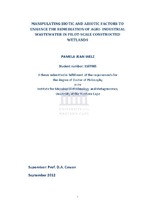| dc.description.abstract | As a consequence of various cellar activities the wine industry produces copious volumes of potentially hazardous wastewater each year. South Africa is one of the top ten wine-producing countries, making the successful treatment of cellar effluent an important environmental obligation in this country. Constructed wetlands (CWs) are resilient to the seasonal input fluxes associated with agri-industrial waste and are ideal systems for the in-situ treatment of cellar effluent in small to medium-sized wineries not connected to municipal reticulation systems. In a project sponsored by the Water Research Commission of South Africa, a number of studies were undertaken to assess the remediation of winery wastewater and common components of winery wastewater in sand-filled pilot-scale constructed wetlands operated in batch mode. This thesis contains the results of three studies. The first study evaluated the temporal aspects of CW equilibration as a basis for future studies of system response to amendment. Microbial biomass and hydraulic conductivity values were monitored and microbial community fingerprints were obtained using denaturing gradient gel electrophoresis. The study showed that microbial community fingerprinting provides a valuable tool to assess the time-scales of microbial equilibration, which was found to be in the order of 100 days. In the second study, the biodegradation and mineralization of ethanol by acclimated and non-acclimated microbial populations in CWs were compared. By increasing the influent ethanol concentration at incremental intervals (incremental priming), the biodegradative capacity was significantly enhanced. At an influent COD concentration of 15 800 mg/L, no volatile fatty acids were detected in the effluent of an incrementally primed system and the maximum effluent COD measured was 180 mg/L. In contrast, an identical, unprimed system, amended with a lower concentration of COD (7587 mg/L), exhibited a maximum effluent COD concentration of 1 400 mg/L, with the metabolites butyrate and propionate accounting for up to 83% of the effluent COD. It was conclusively demonstrated that the use of incremental priming, together with the batch mode of operation enhanced long-term function of the CWs. In the third study, the removal of the phenolic component of winery wastewater was evaluated in CWs, as well as in sand columns and microcosms. It was found that at low influent phenolic concentrations in CWs, complete organic removal was accomplished, but at high concentrations, there was incomplete substrate removal and an accumulation of potentially toxic metabolites, including catechol. The sand provided a suitable substrate for the treatment of phenolic-laden waste, and both biotic (48%) and abiotic (52%) removal mechanisms effected the removal of model phenolics. Prior acclimation of microbial communities increased the biodegradation rate of phenolic acids significantly. | en_US |

